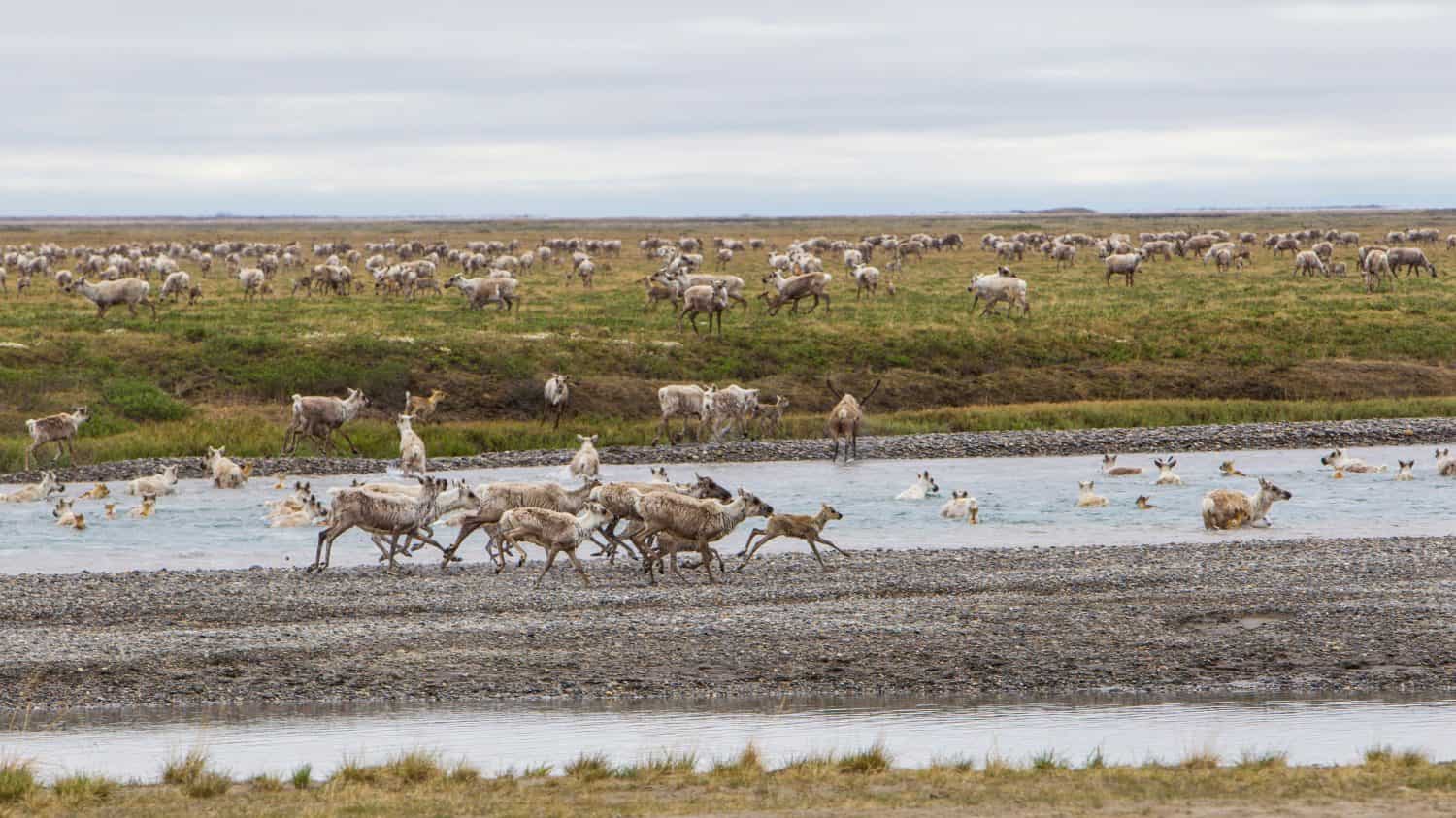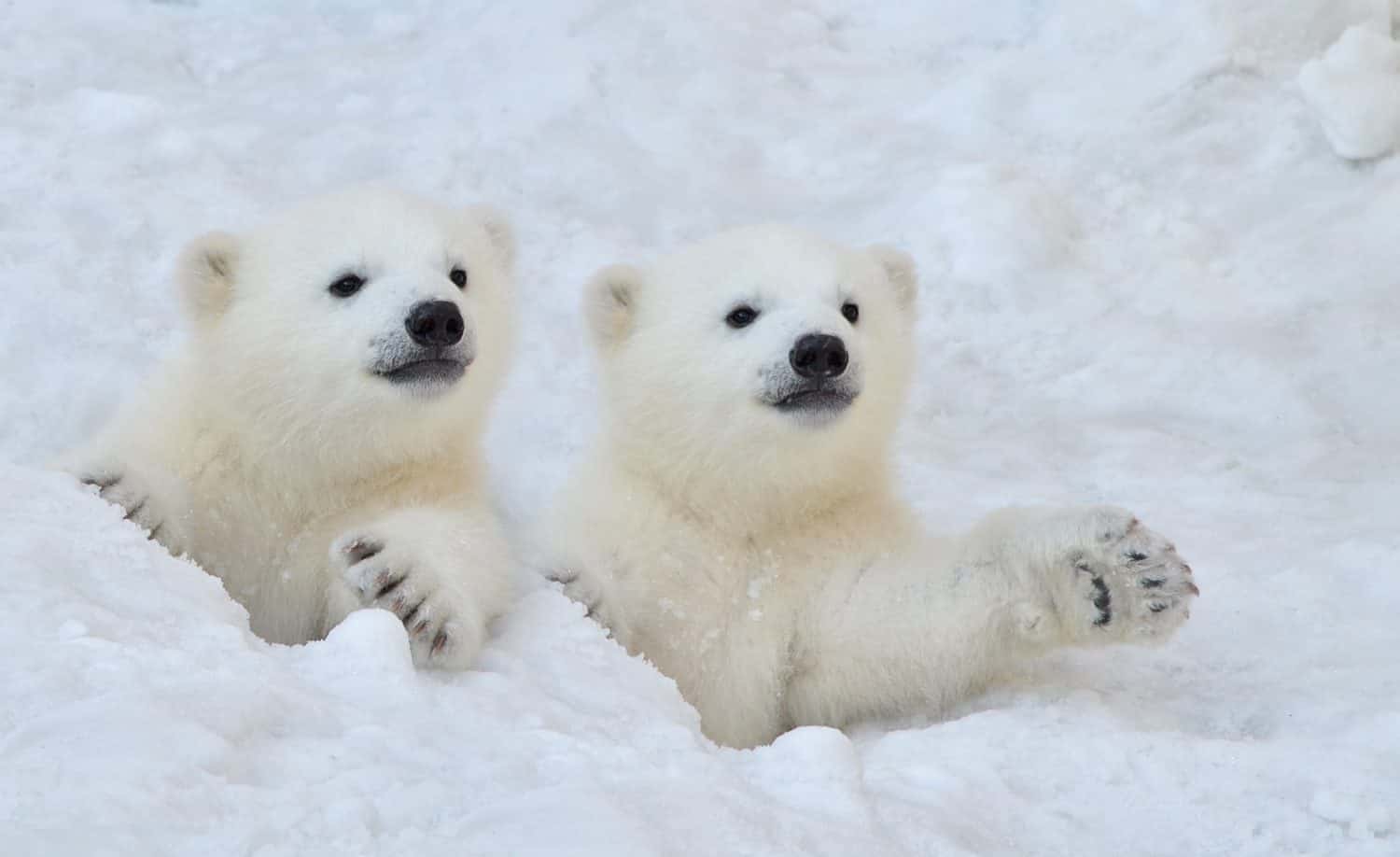The largest national wildlife refuge spans more than 19,286,000 acres in northeastern Alaska. Spread over various landscapes and regions, the Arctic National Wildlife Refuge (ANWR) is approximately the size of the state of South Carolina. Additionally, it is the biggest and wildest publicly owned land throughout the country.
About the ANWR
Also known as the Arctic Refuge, the massive area was established in 1960 and is managed by the U.S. Fish and Wildlife Service. By 1980, the area was renamed and expanded by 18 million acres. Today, the Arctic National Wildlife Refuge covers over 19.6 acres.

The ANWR is home to the largest herd of porcupine
caribou
.
©Danita Delimont/Shutterstock.com
The borders of the ANWR are the Canning River in the west, the Beaufort Sea to the north, the Brooks Mountain Range to the south, and the Alaska-Canada border to the east.
Population and Villages
For thousands of years, two permanent villages have existed here: Kaktovik and Arctic Village. Kaktovik is an Inupiaq village that has approximately 250 residents. The Arctic Village houses a smaller population; 150 people reside within this Gwich’in village.
There is archeological proof that the Arctic Village may date back to 4500 BC, while the Gwich’in Village dates back to 500 AD. The permanent Gwich’in Village was settled around 1900 and is still vibrant, with seasonal hunting and fishing camps.
The Inupiaq and Gwich’in (also known as The Caribou People) still reside within the ANWR today and rely on the refuge for their livelihood.
Getting There
Aside from the Arctic Village along the southern edge of the refuge, there are no roads, villages, campgrounds, or facilities anywhere throughout the refuge.
There are no roads leading into the refuge, and no facilities located within its borders. Dalton Highway brushes a slight portion of ANWR. This connection is just north of Atigun Pass. A few visitors park here, choosing to hike into the refuge. However, most travelers choose to take a flight from Fairbanks to Kaktovik, Fort Yukon, Deadhorse, or Coldfeet. From there, chartered flights land on a gravel river bar or tundra within the Arctic National Wildlife Refuge.
While most visitors bring their own gear and food with them and arrive via personal plane or chartered air taxi, some attend as participants in a group guided tour.
Overview of Activities
There are plenty of activities to take part in within the vast area. A few examples include wildlife photography, rafting, and hiking. Some visit just for the peacefulness of the remote wilderness. There’s no cell phone service here, but satellite phones are always a safe bet.
Plenty of exploration is available throughout the ANWR, with each day providing a different adventure. A popular way of traveling is via raft. Outfitters lead trips down the Canning, Hulahula, Sheenjek, and Kongakut Rivers each summer. Custom tours can be set up for specific interests and scheduling needs.
Tour companies provide the proper gear to explore the wild backcountry, complete with an experienced guide.
Some air taxi operators provide one-day, sightseeing trips. Visitors on extended boat tours may spot polar bears along the shoreline.
Other activities enjoyed within the largest national wildlife refuge include hunting, rafting, fishing, canoeing, pack rafting, berry picking, birding, and wildlife viewing.
Wildlife
Throughout the massive ANWR, there are 42 species of fish, seven marine mammals, and 39 land mammals.

Polar bear
cubs are a wildlife photographer’s dream.
©evaurban/Shutterstock.com
For the polar bears, the refuge serves as an important denning area. It is also a critical calving area for the porcupine caribou herd, one of the largest caribou herds residing within the Arctic National Wildlife Refuge. The herd consists of nearly 200,000 animals and migrates throughout ANWR.
Land Mammals (39)
The Arctic Refuge is home to all three species of North American bears: polar, black, and brown. Polar bears are marine mammals, as opposed to black bears and brown bears, which are land mammals. The polar bear is also considered the largest of the extant bear species. It has the highest number of land dens throughout the state of Alaska.
Brown bears, also commonly known as grizzly bears, are the second largest bear. And, due to the long cold winters, these animals are known to hibernate for up to eight months each year.
Living alongside the caribou are muskox, wolves, Dall sheep, wolverines, and the central Arctic caribou herd. Caribou make the trip to the coastal plain during the summer months of June and July to give birth and raise their offspring.
Coyotes and gray wolves are residents within the Arctic Refuge, along with the Canada lynx. This medium cat breed has long legs, long ear tufts, and a black-tipped tail. Heavily furred paws help insulate them from the cold temperatures.
Marine Mammals (7)
Within the Arctic Refuge, there are killer whales, humpback whales, blue whales, walrus, sperm whales, and the harbor porpoise. Ringed seals reside here as well, along with northern fur seals.

Blue whales are just one of many whale species found within the ANWR.
©tane-mahuta/iStock / Getty Images Plus via Getty Images
Fish Species (42)
Among the many species of fish are the chum salmon, coho salmon, blueback salmon, rainbow smelt, arctic grayling, and Dolly Varden. Other species include the longnose sucker and burbot.
Birds (200+)
This refuge is also a great place to view a plethora of birds, as over 200 species can be found throughout the Alaska park. Many of the birds found within the refuge don’t reside here year-round. Migratory birds arrive from several different continents from April to July each year, to feed, rest, or breed.
Birdwatchers can expect to see the northern goshawk, sharp-shinned hawk, golden eagle, mallard, or the short-eared owl. Visitors may also spot Eurasian teal, lesser scaup, ruffed grouse, and the upland sandpiper.
Landscapes
Portions of the refuge are vastly different from one another. For example, Brooks Range in the east displays the treeless Arctic Coast, while the Porcupine River Valley consists of the taiga.
The coastal plain reaches from the coast to the foothills of Brooks Range. It sees tens of thousands of snow geese during September.
The majestic Brooks Range dominates the refuge. With peaks and glaciers, the rugged mountains run east to west, extending 75 miles wide. Contrasting with the tundra-covered, flat plain, the mountain range also contains numerous streams and rivers, and lacks trees. However, the valleys south of the continental divide is covered in spruce trees. It is also dotted with sloughs and lakes.
On the northern border, there are barrier islands, salt marshes, coastal lagoons, and river deltas that provide habitat for many migratory waterbirds. Sea ducks, swans, geese, and shorebirds land here each year.
Climate
Varied just as much as the landscape, the climate throughout the area runs the gamut of temps and precipitation. September through May is known for its blankets of snow. Freezing temperatures can happen during any month of the year, in any region of the ANWR, especially the mountainous areas. Like with the contiguous states, June, July, and August are the summer months.
Near the coastline, expect strong winds with cooler temperatures, along with clouds and fog. However, inland areas boast blue skies and moderate temperatures with variable winds.
Travelers exploring the area south of the mountains can expect more rain, more extreme temperatures, and lighter winds.
The largest national wildlife refuge is often thought of as a crown jewel of Alaska. With a plethora of gorgeous landscapes, vibrant wilderness, untouched nature, and plenty of activities, it’s no wonder nature enthusiasts adore the Arctic National Wildlife Refuge.
The photo featured at the top of this post is © Danita Delimont/Shutterstock.com
Thank you for reading! Have some feedback for us? Contact the AZ Animals editorial team.







